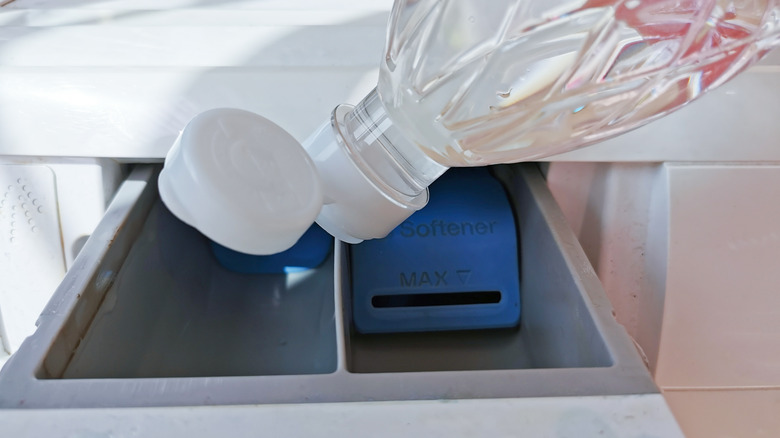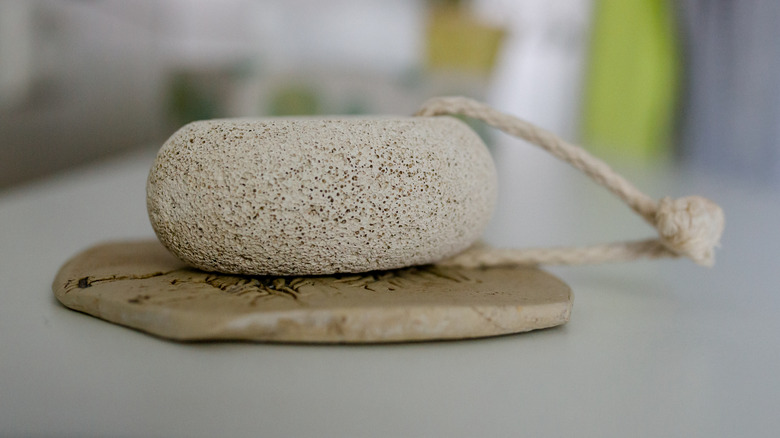Lint-Free Laundry Is Possible With These Genius Tips & Tricks
Lint-covered laundry makes for a frustrating eyesore. Walking around with lint stuck to your pants or shirt can be embarrassing. It can make you want to stay home from work or school — or at a minimum, make you late as you try to pick off all of the noticeable pieces from your outfit. Unfortunately, as easy as the fluff seems to stick to your garments in the washing machine, removing it doesn't always prove to be such an easy task.
However, there are several things you can do to keep your favorite outfits lint-free. Some of these hacks will help save your clothes from becoming fuzzy-looking in the first place. Others will help you learn the quickest and most effective methods for getting the nap off so you can get back to everything you need to do — without feeling self-conscious about what you're wearing. So, whether you've just pulled a fluff-covered shirt out of the dryer that you want to wear to dinner or are finally ready to make a few small changes to protect your clothes from looking so drab and worn out, keep reading.
Separate your laundry to minimize lint
Separating your laundry is essential for several reasons. Beyond the importance of keeping darker clothes from bleeding dye onto lighter ones, separating your laundry can also help reduce lint buildup on your clothes. You need to be cognizant of the different materials and fabrics that you wash together. Otherwise, you're only going to make it more likely for something to come out looking a little fuzzy. Certain fabrics — such as chenille, fleece, and flannel — are notorious for shedding in the washer or dryer. Instead of washing these fabrics with the rest of your load, separate them to protect your other garments.
New clothes and linens also shed a lot of fuzz when they're first washed. Think about how much lint is in the trap of the dryer after you wash a load of new towels. For this reason, along with the fact that some of their coloring may also transfer to your existing clothes, it is always a good idea to wash them separately for the first two washes. The few extra loads of laundry will be worth the frustration you'll save.
Use distilled white vinegar
Distilled white vinegar is a versatile product that can help with so many tasks around the home. You may not be surprised to learn that it can also help you achieve lint-free clothing. To see this benefit of distilled white vinegar in action, simply add about ½ cup of it to your washer during the rinse cycle. The vinegar will relax the fibers in the fabric, making it possible for the agitation action of the washer to pull the fuzz away from your garments. You could even consider mixing a few drops of your favorite essential oil with vinegar to leave your clothes with a slight fragrance.
When you're ready to move the load of laundry to the dryer, toss in a few microfiber cloths. This way, as the fabrics dry, the lint will be attracted to the microfiber, instead of finding its way back onto your clothes. Voilà, now you can revel in yet another use for distilled white vinegar.
Try anti-static spray
Dealing with static cling on your laundry can be frustrating. The status is caused by the clothes rubbing against one another as they tumble around in the dryer. As this happens, electrons pass between the items, leaving some with a negative charge and others with a positive charge. As you probably remember from high school science, these opposite charges attract one another, which is why your clothes cling to each other. The other downside of static is that it attracts lint. So, chances are if you're dealing with static cling issues, then you may also be finding fuzz all over your clothes.
The good news is that you can eliminate both of these problems with one simple solution: anti-static spray. Applying anti-static spray to your clothes will redistribute the electrons and neutralize the charge on the item. Once neutralized, the nap covering your item will also be released, making it much easier to remove.
Turn your clothes inside-out before washing
Taking a few extra seconds to turn your clothes inside out before tossing them in the washing machine or hamper is another effective solution to try. While this method won't necessarily prevent lint from clinging to your clothes, it will keep the nap on the inside of the garments. This will remove some of the self-consciousness that can come with donning an outfit covered with fluffy balls of fuzz.
Turning your garments inside out before washing will also deliver more benefits than keeping the lint out of sight when you wear them. Agitators on a washing machine can be tough on clothes. When you turn them inside out, the outside of the clothes will remain more protected against damage and wear, keeping your items looking new for longer. Another reason to consider turning your clothes inside out is that it will expose the dirtier parts of the laundry. After all, the inside of your outfit is the part that comes into contact with sweat and other bodily fluids.
Use a damp cloth
Sometimes removing lint from your garments can be as easy as using a damp cloth. While this hack won't help you prevent the fuzz from sticking in the first place, it can be a real lifesaver if you're out and realize that you left the house looking, well, a little fuzzy. Just grab a cloth — such as a dish towel, wash cloth, or microfiber cloth — and dampen it. Squeeze out the excess water and rub it gently over any areas where lint is present. Keep an eye on the towel you're working with. If one area starts to get covered with fluff, be sure to switch to using a different section or rinse it off and start over.
The reason this trick works also has to do with static electricity. Remember, earlier we shared that lint is attracted to negatively charged clothes? Well, when you dampen the clothes, you're reducing the electric charge. This releases the fuzz's grip on your clothes and makes it easier to remove.
Rub clothing with a pumice stone
Pumice stones — yes, the same ones that you can use to help smooth out calluses on your feet — can also help with removing fluff and fuzz from your garments. If you've ever used a pumice stone before, then you already know that they have a very rough texture. This coarser texture is what makes them so effective at removing dead skin from your feet, and it is also what makes it a good choice for getting lint off of your clothes. The lint will get picked up and trapped in the textured surface.
Using a pumice stone on your clothes is even easier than using it on your feet. Just lay out the affected garment and rub across it using the stone. Take care not to push too hard so you don't end up pulling the fabric; a light back-and-forth motion over the linty areas should be all you need to do.
Use your hair dryer
Did you know that a hair dryer can also be an effective lint-removal tool? Well, if you pair it with a dryer sheet, it most certainly can be. Begin by hanging up the fluff-covered item on a clothes rack or the back of a door. Hold the dryer sheet in one hand and begin wiping down the garment. Much of the lint is likely going to be attracted to the dryer sheet because of its ability to neutralize static.
To maximize the effectiveness of the dryer sheet, though, add some support from your hair dryer. With it set to cool — not hot — guide it along behind the dryer sheet. This way, the lint that the dryer sheet loosens will be blown away by the blow dryer. Within a few minutes, your favorite outfit will be smooth, clean, and ready to wear out for a night on the town.
Keep a lint roller or lint brush with you
Lint rollers and brushes are available for a reason. Purchasing one or both of these items to have in a drawer at home, in your purse or briefcase, or in the glove compartment can ensure that you're always prepared to deal with a fuzzy mess on your clothes when you have something to do or somewhere to be.
Either option can be a good choice, but there are a few differences between these two tools that may help you determine which is the best fit for your needs. Lint brushes have very soft bristles that attract fuzz and pull it from clothing. You can only move them in one direction at a time and will need to pick them up to change directions. Once they've picked up too much fluff, you'll need to wipe off the lint (or possibly press a button to release it with some newer models). One benefit of this tool is that it can be cleaned and reused over and over again.
Lint rollers feature a plastic handle connected to a roll of sticky paper. As you move them across an item of clothing, the fuzz sticks to the paper. Depending on how much fluff is on the piece you're working on, the sticky paper may become covered quickly. Once it is no longer sticky, you can peel the outer layer off to reveal a new, sticky sheet. Maneuvering a lint roller can be a bit easier. However, they are not as eco-friendly since each sheet is tossed as it fills up.
Invest in an electric lint remover
If you really want to simplify your life and keep all of your clothes free of fuzz, consider purchasing an electric fabric shaver. These devices do precisely what their name implies: They shave fabrics. The shavers have a small blade that spins when turned on. When users put it up against their garment, the blade will pick up and shave off anything that is sticking out from the fabric, be it a piece of lint or pills that are forming on the surface.
With a fabric shaver, you're able to refresh your clothes and ensure they stay looking their best for a long time. They're relatively straightforward and easy to use and are small enough to fit comfortably in the palm of your hand. Look closely at the product descriptions when shopping for a fabric shaver. Some are designed as more of a general-use tool for different types of materials, while others may be specifically designed for use on one particular type of fabric.









